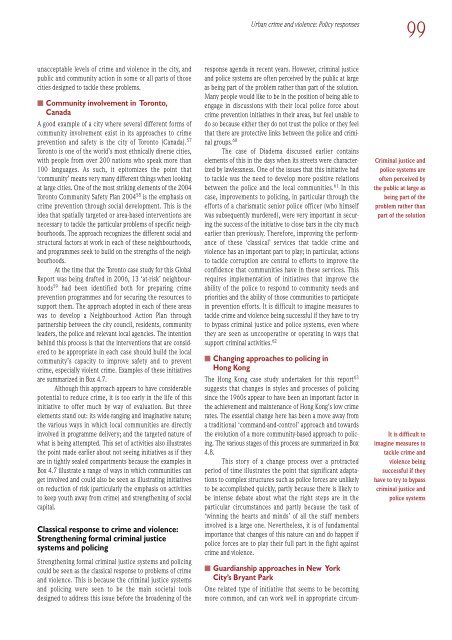Download the file - United Nations Rule of Law
Download the file - United Nations Rule of Law
Download the file - United Nations Rule of Law
- No tags were found...
Create successful ePaper yourself
Turn your PDF publications into a flip-book with our unique Google optimized e-Paper software.
Urban crime and violence: Policy responses99unacceptable levels <strong>of</strong> crime and violence in <strong>the</strong> city, andpublic and community action in some or all parts <strong>of</strong> thosecities designed to tackle <strong>the</strong>se problems.■ Community involvement in Toronto,CanadaA good example <strong>of</strong> a city where several different forms <strong>of</strong>community involvement exist in its approaches to crimeprevention and safety is <strong>the</strong> city <strong>of</strong> Toronto (Canada). 57Toronto is one <strong>of</strong> <strong>the</strong> world’s most ethnically diverse cities,with people from over 200 nations who speak more than100 languages. As such, it epitomizes <strong>the</strong> point that‘community’ means very many different things when lookingat large cities. One <strong>of</strong> <strong>the</strong> most striking elements <strong>of</strong> <strong>the</strong> 2004Toronto Community Safety Plan 2004 58 is <strong>the</strong> emphasis oncrime prevention through social development. This is <strong>the</strong>idea that spatially targeted or area-based interventions arenecessary to tackle <strong>the</strong> particular problems <strong>of</strong> specific neighbourhoods.The approach recognizes <strong>the</strong> different social andstructural factors at work in each <strong>of</strong> <strong>the</strong>se neighbourhoods,and programmes seek to build on <strong>the</strong> strengths <strong>of</strong> <strong>the</strong> neighbourhoods.At <strong>the</strong> time that <strong>the</strong> Toronto case study for this GlobalReport was being drafted in 2006, 13 ‘at-risk’ neighbourhoods59 had been identified both for preparing crimeprevention programmes and for securing <strong>the</strong> resources tosupport <strong>the</strong>m. The approach adopted in each <strong>of</strong> <strong>the</strong>se areaswas to develop a Neighbourhood Action Plan throughpartnership between <strong>the</strong> city council, residents, communityleaders, <strong>the</strong> police and relevant local agencies. The intentionbehind this process is that <strong>the</strong> interventions that are consideredto be appropriate in each case should build <strong>the</strong> localcommunity’s capacity to improve safety and to preventcrime, especially violent crime. Examples <strong>of</strong> <strong>the</strong>se initiativesare summarized in Box 4.7.Although this approach appears to have considerablepotential to reduce crime, it is too early in <strong>the</strong> life <strong>of</strong> thisinitiative to <strong>of</strong>fer much by way <strong>of</strong> evaluation. But threeelements stand out: its wide-ranging and imaginative nature;<strong>the</strong> various ways in which local communities are directlyinvolved in programme delivery; and <strong>the</strong> targeted nature <strong>of</strong>what is being attempted. This set <strong>of</strong> activities also illustrates<strong>the</strong> point made earlier about not seeing initiatives as if <strong>the</strong>yare in tightly sealed compartments because <strong>the</strong> examples inBox 4.7 illustrate a range <strong>of</strong> ways in which communities canget involved and could also be seen as illustrating initiativeson reduction <strong>of</strong> risk (particularly <strong>the</strong> emphasis on activitiesto keep youth away from crime) and streng<strong>the</strong>ning <strong>of</strong> socialcapital.Classical response to crime and violence:Streng<strong>the</strong>ning formal criminal justicesystems and policingStreng<strong>the</strong>ning formal criminal justice systems and policingcould be seen as <strong>the</strong> classical response to problems <strong>of</strong> crimeand violence. This is because <strong>the</strong> criminal justice systemsand policing were seen to be <strong>the</strong> main societal toolsdesigned to address this issue before <strong>the</strong> broadening <strong>of</strong> <strong>the</strong>response agenda in recent years. However, criminal justiceand police systems are <strong>of</strong>ten perceived by <strong>the</strong> public at largeas being part <strong>of</strong> <strong>the</strong> problem ra<strong>the</strong>r than part <strong>of</strong> <strong>the</strong> solution.Many people would like to be in <strong>the</strong> position <strong>of</strong> being able toengage in discussions with <strong>the</strong>ir local police force aboutcrime prevention initiatives in <strong>the</strong>ir areas, but feel unable todo so because ei<strong>the</strong>r <strong>the</strong>y do not trust <strong>the</strong> police or <strong>the</strong>y feelthat <strong>the</strong>re are protective links between <strong>the</strong> police and criminalgroups. 60The case <strong>of</strong> Diadema discussed earlier containselements <strong>of</strong> this in <strong>the</strong> days when its streets were characterizedby lawlessness. One <strong>of</strong> <strong>the</strong> issues that this initiative hadto tackle was <strong>the</strong> need to develop more positive relationsbetween <strong>the</strong> police and <strong>the</strong> local communities. 61 In thiscase, improvements to policing, in particular through <strong>the</strong>efforts <strong>of</strong> a charismatic senior police <strong>of</strong>ficer (who himselfwas subsequently murdered), were very important in securing<strong>the</strong> success <strong>of</strong> <strong>the</strong> initiative to close bars in <strong>the</strong> city muchearlier than previously. Therefore, improving <strong>the</strong> performance<strong>of</strong> <strong>the</strong>se ‘classical’ services that tackle crime andviolence has an important part to play; in particular, actionsto tackle corruption are central to efforts to improve <strong>the</strong>confidence that communities have in <strong>the</strong>se services. Thisrequires implementation <strong>of</strong> initiatives that improve <strong>the</strong>ability <strong>of</strong> <strong>the</strong> police to respond to community needs andpriorities and <strong>the</strong> ability <strong>of</strong> those communities to participatein prevention efforts. It is difficult to imagine measures totackle crime and violence being successful if <strong>the</strong>y have to tryto bypass criminal justice and police systems, even where<strong>the</strong>y are seen as uncooperative or operating in ways thatsupport criminal activities. 62■ Changing approaches to policing inHong KongThe Hong Kong case study undertaken for this report 63suggests that changes in styles and processes <strong>of</strong> policingsince <strong>the</strong> 1960s appear to have been an important factor in<strong>the</strong> achievement and maintenance <strong>of</strong> Hong Kong’s low crimerates. The essential change here has been a move away froma traditional ‘command-and-control’ approach and towards<strong>the</strong> evolution <strong>of</strong> a more community-based approach to policing.The various stages <strong>of</strong> this process are summarized in Box4.8.This story <strong>of</strong> a change process over a protractedperiod <strong>of</strong> time illustrates <strong>the</strong> point that significant adaptationsto complex structures such as police forces are unlikelyto be accomplished quickly, partly because <strong>the</strong>re is likely tobe intense debate about what <strong>the</strong> right steps are in <strong>the</strong>particular circumstances and partly because <strong>the</strong> task <strong>of</strong>‘winning <strong>the</strong> hearts and minds’ <strong>of</strong> all <strong>the</strong> staff membersinvolved is a large one. Never<strong>the</strong>less, it is <strong>of</strong> fundamentalimportance that changes <strong>of</strong> this nature can and do happen ifpolice forces are to play <strong>the</strong>ir full part in <strong>the</strong> fight againstcrime and violence.■ Guardianship approaches in New YorkCity’s Bryant ParkOne related type <strong>of</strong> initiative that seems to be becomingmore common, and can work well in appropriate circum-Criminal justice andpolice systems are<strong>of</strong>ten perceived by<strong>the</strong> public at large asbeing part <strong>of</strong> <strong>the</strong>problem ra<strong>the</strong>r thanpart <strong>of</strong> <strong>the</strong> solutionIt is difficult toimagine measures totackle crime andviolence beingsuccessful if <strong>the</strong>yhave to try to bypasscriminal justice andpolice systems
















